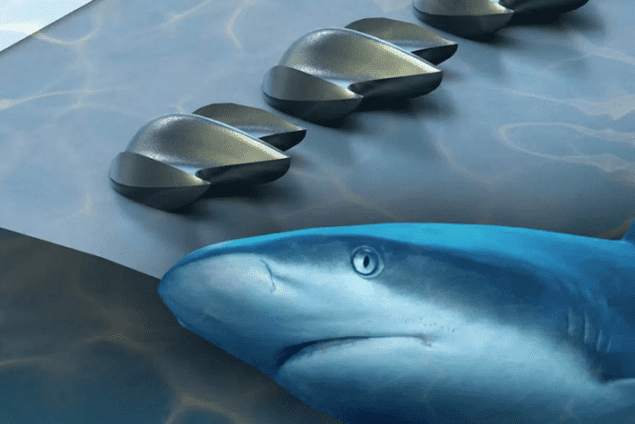
A shark skin-inspired design can dramatically improve the lift of an aerofoil, according to researchers in the US. The tiny tooth-like scales on a shark’s skin called denticles have previously been shown to reduce drag, this latest research shows that they also boost the lift-to-drag ratio of an aerofoil. As well as offering paths to improved aerodynamic design, the researchers say that their work provides important insight into the role of shark morphology on swimming efficiency.
Like most fish, a shark’s skin is covered in scales. But shark scales are different to those of most fish. Known as dermal denticles, they resemble teeth, and their top surfaces feature ridges that run from front to back. “Their structure varies from species to species and even within different regions of a shark,” explains August Domel at Harvard University.
Thrust generation
Previous studies have shown that the denticles generate vortexes that reduce drag, improving the hydrodynamic performance of sharks and allowing them to swim faster. But Domel and colleagues, wondered if there was more to the story. “We hypothesized that on a shark, these denticles may also be beneficial for thrust generation by enhancing the force normal to the denticle,” Domel told Physics World. “With this in mind, we wanted to know if these denticles could, on an aerofoil, enhance the force normal to the denticle – generating lift – and reducing drag.”
To test their theory, the researchers looked to the fastest shark in the world, the shortfin mako, Isurus oxyrinchus. They took micro-computed tomography scans of the shark’s denticles and then 3D printed 20 aerofoils with idealized models of the denticles on the top edge. The model denticles had a curved profile, from front to back, and three ridges: a central ridge, and two lower profile and shorter outer ridges that curved inwards slightly at the front. They were the same shape across the different aerofoils, but varied in arrangement (single or multiple rows), position, size and tilt angle.
Enhanced performance
When the researchers tested these aerofoils in a water flow tank they found that while most behaved similarly to a denticle-free control, some exhibited significantly enhanced performance. The best performing aerofoil featured a single row of roughly 2 mm wide denticles spaced 1 mm apart, positioned a quarter of the way along the length of the aerofoil from the front.
On this best performing aerofoil, at almost all angles of attack lift was increased and drag was reduced, compared with the denticle-free control. The denticle aerofoil even generated lift at zero angle of attack, while the control generated none. Overall, the denticles created lift-to-drag ratio improvements of up to 323%, compared with the control.
Separation bubble
According to the researchers, there are two mechanisms responsible for these results. The denticles generate a short separation bubble that provides extra suction to the aerofoil, enhancing lift, and the curvature of the denticles creates low-profile vortexes that reduce drag and prevent lift losses at higher angles of attack.
By increasing lift, the researchers say, that the shark skin probably enhances thrust and increases the shark’s self-propelled swimming speeds. They add that the mechanisms discovered could also be used to improve aerodynamic design.
“All lifting surfaces in aerial devices, such as drones, airplanes, and wind turbines, are composed of aerofoils,” explains Domel. “Enhancing lift and reducing drag on an aerofoil ultimately leads to lower energy consumption for these aerial devices, and our designs have shown a lot of potential so far in improving these aerodynamic features on an aerofoil.”
The research is described in Journal of the Royal Society Interface.



